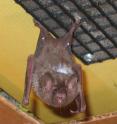Brown-led team offers first look at how bats land
People have always been fascinated by bats, but the scope of that interest generally is limited to how bats fly and their bizarre habit of sleeping upside down. Until now, no one had studied how bats arrive at their daytime perches. A Brown University-led research team is the first to document the landing approaches of three species of bats — two that live in caves and one that roosts in trees. What they found was surprising: Not all bats land the same way.
"Hanging upside down is what bats do," said Daniel Riskin, a postdoctoral researcher in the Ecology and Evolutionary Biology department at Brown and lead author on a paper published in the Journal of Experimental Biology. "We've known this. But this is the first time anyone has measured how they land."
Using sophisticated motion capture cameras in a special flight enclosure, the team filmed each species of bat as it swooped toward a latticed landing pad and landed on it. Cynopterus brachyotis, a tree-roosting bat common in tropical parts of southeast Asia, executed a half-backflip as it swooped upward to the landing site, landing as its hind legs and thumbs touched the pad simultaneously — a four-point landing, the group observed.
The landing is hard, Riskin noted, with an impact force more than four times the species' body weight.
The team then turned its attention to two cave-roosting species, Carollia perspicillata and Glossophaga soricina. These bats, common in Central and South America, approach their landing target with a vertical pitch and then, at the last instant, yaw to the left or to the right — executing a cartwheel of sorts — before grasping the landing pad with just their hind legs.
The two-point landing is much gentler than the impact force exerted by the tree-roosting bats, the researchers observed; the cave-roosting bats have a landing impact force of just one-third of their body weight.
There are about 1,200 recognized bat species worldwide, so Riskin was cautious about not drawing any grand conclusions. Still, he said, the fact that the team has documented that bats land differently could open new insights into a species that makes up roughly one-fifth of all mammals on earth.
"It's opening the door to how bats evolved," Riskin said. "You can say that bats have been hanging upside down since they first evolved, and it has probably been one of the keys to their worldwide success."
Source: Brown University
Other sources
- Not All Bats Land The Same Wayfrom Science DailyFri, 20 Mar 2009, 22:35:29 UTC
